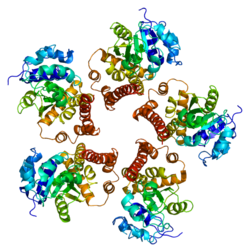Top Qs
Timeline
Chat
Perspective
PYCR1
Protein-coding gene in the species Homo sapiens From Wikipedia, the free encyclopedia
Remove ads
Pyrroline-5-carboxylate reductase 1, mitochondrial is an enzyme that in humans is encoded by the PYCR1 gene.[5][6]
This gene encodes an enzyme that catalyzes the NAD(P)H-dependent conversion of pyrroline-5-carboxylate to proline. This enzyme may also play a physiologic role in the generation of NADP(+) in some cell types. The protein forms a homopolymer and localizes to the mitochondrion. Alternate splicing results in two transcript variants encoding different isoforms.[6] As reported by Bruno Reversade and colleagues, PYCR1 deficiency in humans causes a progeroid disease known as De Barsy Syndrome mainly affecting connective tissues with dermis thinning and bone fragility.[7]
Remove ads
References
Further reading
External links
Wikiwand - on
Seamless Wikipedia browsing. On steroids.
Remove ads






